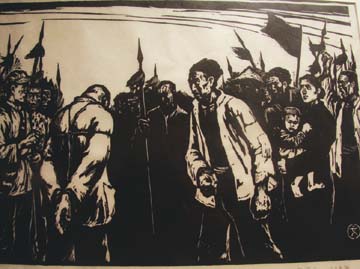|

While before the 1980s, the artist, like most Chinese, intentionally or unintentionally catered to certain political themes, his works created after 1979 were free from political constraints.
Deng Hanneng
IN 1961, Song Yuanwen, then a printmaking student at the Central Academy of Fine Arts, submitted his course work. It was two pieces of woodcut printing that showed the scenes of harvest.
The happy faces of the farmers and the golden crops in the two prints, “Harvest” and “August,” were a sharp contrast with the famine that was plaguing China at the time. Yet it fits well with the optimistic political atmosphere of the period.
“The artworks had ideological constraints, yet I feel the farmers I came into contact with during the course of my research were generally very optimistic about their country,” Song wrote in the notes for his artworks.
Song Yuanwen, 78, is one of the best-known printmakers in China. His works, mostly landscape prints, are being shown at the Guan Shanyue Art Museum.
The exhibition shows 49 of Song’s prints, as well as illustrations and sketches. The prints, the oldest of which date back to the 1950s, not only offer a visual treat to visitors, but also educate people about China’s tempestuous recent history. Most of the political movements between the 1950s and the 1980s are represented in Song’s artworks.
Print “A Class in the Field” was created in 1958, when China was undergoing the Great Leap Forward and students were encouraged to leave campus to work in the countryside.
“The Tempest”, an illustration for well-known novelist Zhou Libo’s novel on land reform by the Communist Party of China, shows a landlord being tied up by angry peasants in the 1940s.
A 1963 print titled “Early Spring” shows a female student walking into the field — a reflection of the Going to the Countryside movement that encouraged young students to leave the city.
Song’s “Fights at the Equator” series represents the independence movements in Asia, Africa and Latin America in the 1960s.
The print “Sleepless Land” was made in 1979, when the artist lived on a farm in Northwest China’s Heilongjiang Province. The tractors were working overnight. Unable to sleep, Song went walking in the field and felt the land trembling. Then he made “Sleepless Land” to signify the changes brought about by the reform and opening up. The wild geese at the center of the scene, desperate to fly in spite of their weight, embodied China, according to the artist.
While before the 1980s, the artist, like most Chinese, intentionally or unintentionally catered to certain political themes, his works created after 1979 were free from political constraints.
“After the Culture Revolution, my understanding of realism changed,” the artist said. “I abandoned shallow realism and began to imagine people’s deepest thoughts.”
Thus came more lively artworks. “Mature Apples,” made in 1979, displays an evocative use of the color red, and “Summer,” made in 1980, makes equally powerful use of green.
Age has not slowed Song down. His contemporary works are also on show at the exhibition.
The exhibition is one of the events that will mark 2011 as the Printmaking Year named by the Chinese Artists Association.
Printmaking emerged in China more than 1,000 years ago, although prior to the 1930s, the most recognized form was the woodcut. The art became popular in the mid-20th century, after foreign techniques were introduced. As a print artist who dedicated all his life to making prints and teaching, Song himself embodies the history of contemporary printmaking in China.
The exhibition ends Oct. 30. Dates: Through Oct. 30
Hours: 9 a.m.-5 p.m. Closed Monday
Venue: Guan Shanyue Art Museum (关山月美术馆)
Add: 6026 Hongli Road, Futian District (福田区红荔路6026号)
Metro: Children’s Palace Station (少年宫站), Exit B
|

